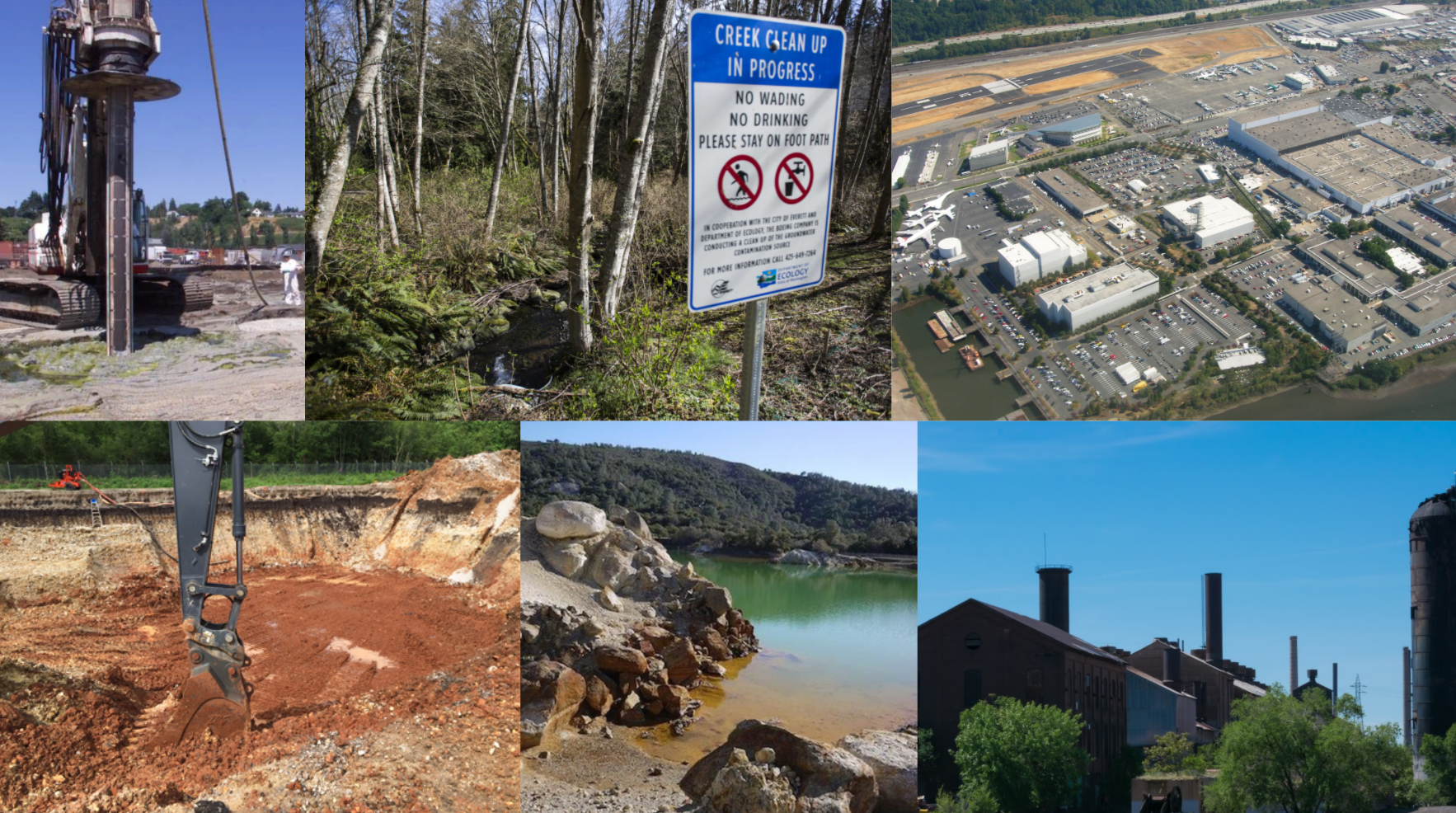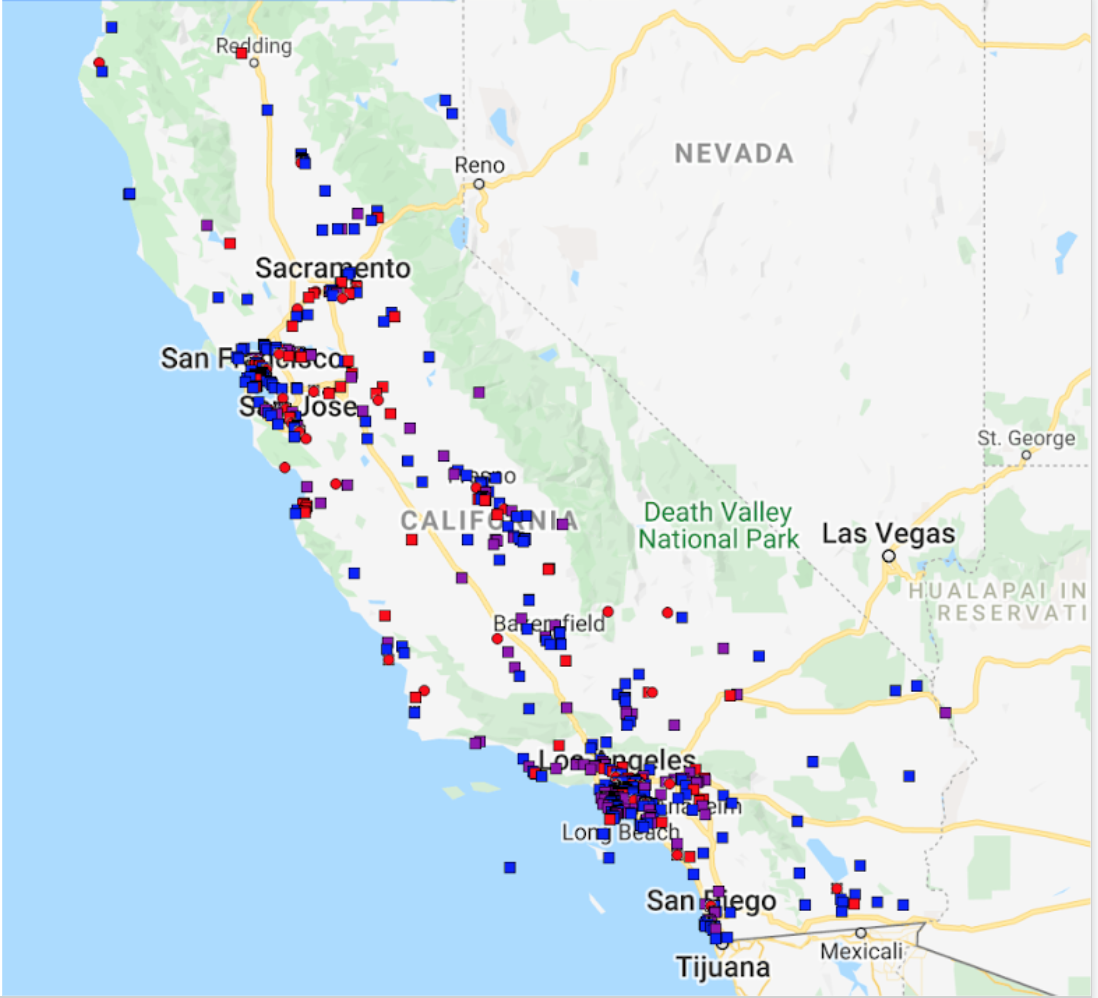Responsible parties
Quicklinks: Boeing Corporation | Department of Energy | CAL EPA AND DTSC | NASA
The cleanup of the Santa Susana Field Lab is divided by the three responsible parties: NASA, DOE and Boeing
The Boeing Corporation
The Boeing Company purchased Aerojet Rocketdyne Company in 1996, and with it, the Santa Susana Field Lab. Boeing used the site for testing. Boeing owns the majority of the site and is financially responsible for a majority of the cleanup in Area IV.
Boeing signed a cleanup agreement in 2007 with California’s Department of Toxic Substances Control to remediate the site to comply with environmental laws and to match the existing zoning of the area.
Read about the 2007 agreement Boeing signed to cleanup the SSFL
Boeing has worked extensively to break their agreement utilizing lobbyists, lawyers, PR firms, astroturfers, and poaching employees from government agencies. Currently (Spring 2022), Boeing has continued private mediations with the DTSC and the Los Angeles Water Board. It is expected that Boeing will advocate to leave up to 90% of the contamination on site and completely walk away from remediating the groundwater.
Private Mediation with DTSC
The SSFL is a public site and is subject to CEQA, a law meant to keep decision makers and the public informed about the cleanup process and gives the opportunity for residents to comment on DTSC decisions and actions. Boeing’s private mediation may break this law, and most certainly goes against the intent of the law.
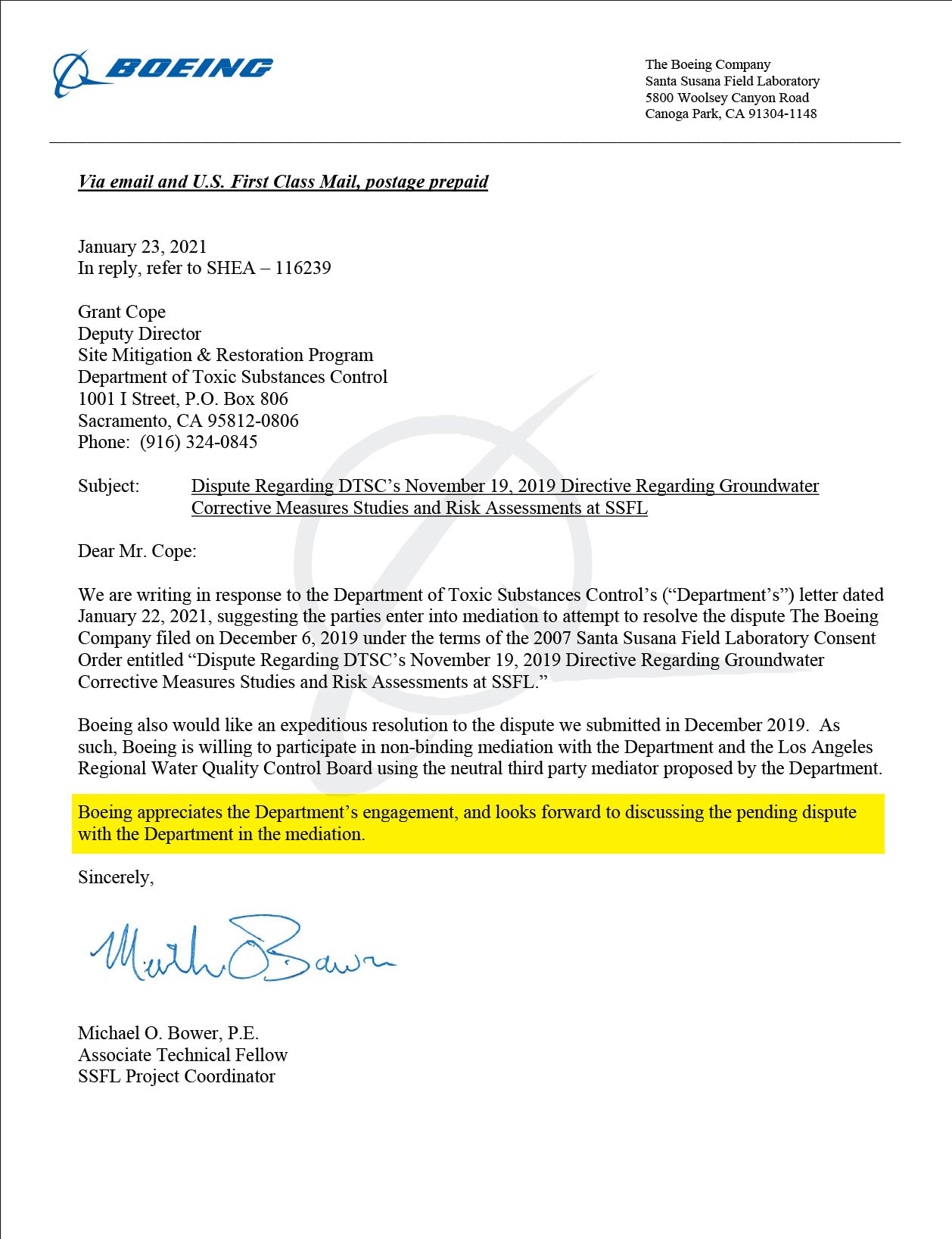

Despite DTSC’s 2007 cleanup agreements with Boeing, they have recently entered into new negotiations along with the Los Angeles Regional Water Quality Control Board, privately, baring both public comments and elected official representation in the meetings. It is assumed the outcome of the negotiations will allow Boeing to walk away from all groundwater remediation and will allow them to use a “residential cleanup with 25% garden,” that will actually leave the great majority of the contamination on site.
Boeing has hired PR firms, lawyers, lobbyists and made questionable donations in order to avoid paying for the majority of the SSFL’s cleanup. Read more about their decades of greenwashing campaigns >
other communities failed by Boeing
The Tulalip Test Site, on the Tulalip Tribes Indian Reservation in Marysville, Washington. Investigation and cleanup of the site is ongoing. The site is not listed on the National Priorities List (NPL) but is an NPL-caliber site and is being addressed through the Superfund Alternative Approach.
Boeing Plant 2 is located on the east bank of the Duwamish Waterway in Seattle and Tukwila, Washington. The Boeing Plant 2 is a Resource Conservation and Recovery Act (RCRA) hazardous waste facility. Metals, solvents, PCBs and other contamination remain in certain areas of the facility. The Boeing Company is under a RCRA Order from EPA to investigate and clean up Plant 2.
Boeing Engr Uranium Enrichment Plant. Oakridge, Tennessee. In process of a federal facility-lead cleanup. This is a Superfund site , but not on NPL list.
Boeing Company N Field Seattle CY Light. Seattle, Washington. This is a Superfund site , but not on NPL list.
Department of Energy
background
The Department of Energy (DOE) signed the 2010 cleanup agreement with California’s Department of Toxic Substances Control (DTSC), which would require a cleanup on their portion of the SSFL to background levels. The DOE refers their portion of the SSFL the “Energy, Technology, and Engineering Center (ETEC).”
Congressman Brad Sherman questioned Secretary of Energy Rick Perry on the slow federal response to the Santa Susana Field Lab Meltdown, Jun 25, 2019
In 2018 the DOE publicly declared they would not honor their legal agreements by publishing their own EIS to leave a majority of the contamination on site.
2020
The DOE agreed to an emergency consent order to demo ten of the Radioactive Materials Handling Facility buildings according to the 2010-AOC cleanup regulations, to mitigate potential risk from wildfires at SSFL.
However, it's the soil that's highly contaminated, but this order won't remediate the soil at all. The soil is an even bigger risk than the buildings. We must demand that the DOE recommit itself to all of the requirements in the AOC agreement. And that DTSC hold them to it. Otherwise this is simply another attempt to look busy while doing little.
further reading:
other communities failed by doe
Paducah Gaseous Diffusion Plant (USDOE). Paducah, Kentucky. The site is the location of a former uranium enrichment plant owned by the U.S. Department of Energy (DOE). Uranium enrichment activities ceased in 2013. Current site missions include environmental cleanup, waste disposition, depleted uranium conversion, deactivation and decommissioning of the former uranium enrichment facilities, and long-term stewardship.
DTSC and CalEPA
The California Department of Toxic Substances Control (DTSC) is a department within the California EPA agency.
The DTSC Document Library has copies of all Santa Susana Field Lab reports, Environmental Impact Studies, orders and correspondences involving the EPA and DTSC (physical copies can be found at the Simi Valley Library and Platt Library.)
2019
California Gavin Newsom appoints Jared Blumenfeld to be the new Secretary for the California EPA. Sec. Blumenfeld admitted that the Department of Toxic Substances Control (DTSC) was not a “healthy agency” and had lost public trust. He committed to returning the DTSC to an agency that helps people and not polluters.
2009 and earlier
In 2009 the DTSC worked with CalEPA’s Linda Adams (appointed by California Governor Arnold Schwarzenegger) to ensure the complete cleanup of the Santa Susana Field Lab.
Secretary Adams considered the site so dangerous that the CAL EPA sued in order to bring the site under California’s cleanup jurisdiction (the DTSC) instead of the federal EPA. Adams believed California’s environmental standards to be more strict than the federal.
In addition to the legislature SB990, she also worked to create two cleanup agreements with the polluters, the 2007 Consent Order for Corrective Action (COCA) and in 2010 the Administrative Orders on Consent (AOC).
After Linda Adam’s departure from CalEPA the DTSC took a decisive aboutface. Working closely with Boeing lobbyist, the DTSC constructed an Environmental Impact Reports (EIR) that outrageously violated the agreements signed in the 2007-COCA and 2010-AOC.
Other communities failed by DTSC and CALEPA
NASA
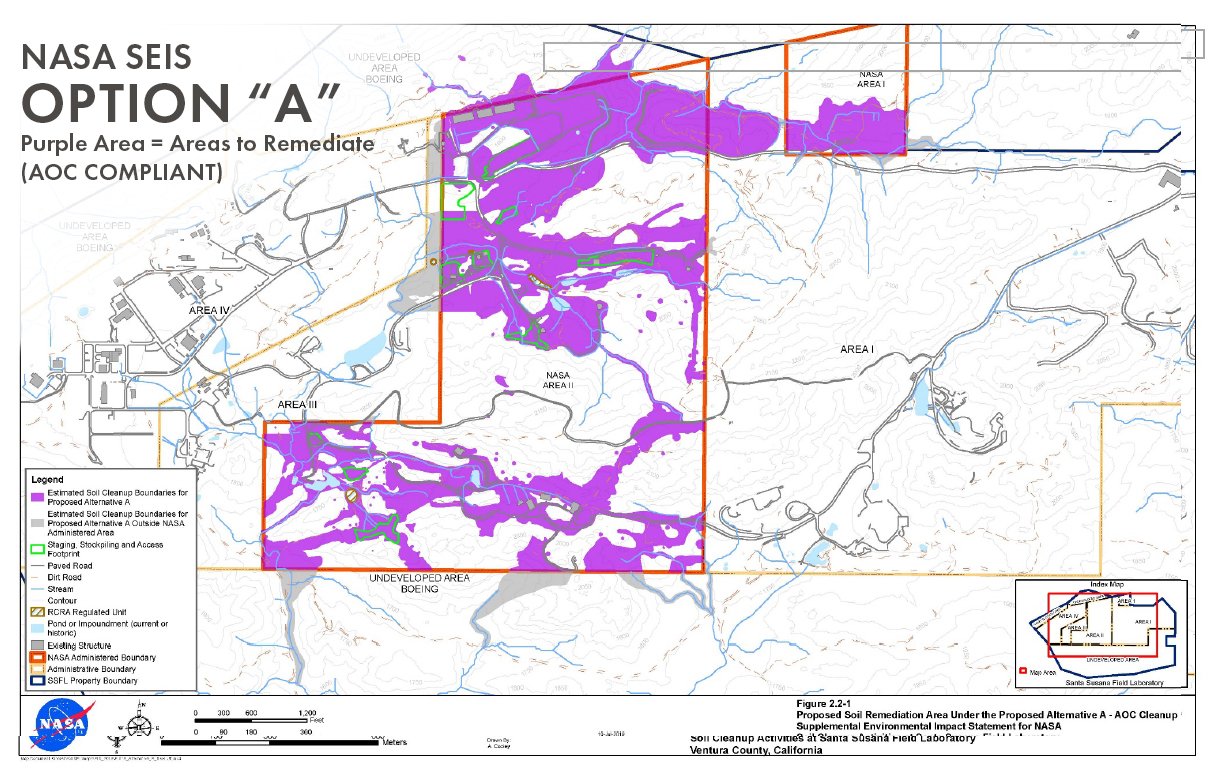

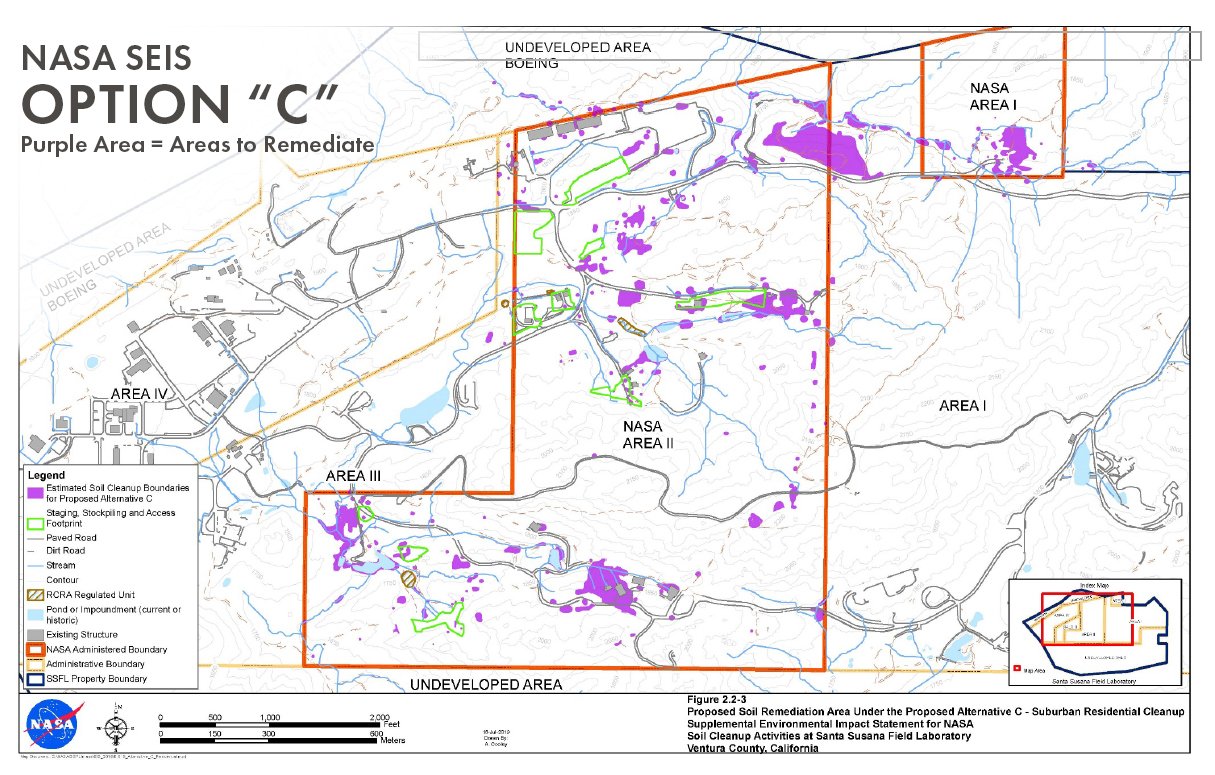

2020: NASA Issues SEIS
October 2, 2020: NASA issued it’s “Record of Decision,” aka ROD. It is the final step for NASA’s supplemental Environmental Statement process (read more why NASA never needed an SEIS).
NASA determined that substantially more soil needed to be removed from its part of the site than what it estimated in the 2014 report so a supplemental report was prepared in 2019
NASA’s ROD selects “Option C” and will leave up to 84% of their portion of the SSFL contaminated. NASA’s property is contaminated with hazardous materials, like trichloroethylene (TCE), perchlorates, PCBs, dioxins, heavy metals, and other toxic chemicals that can cause cancer and other illnesses.
In January 2020 DTSC sent a letter to NASA on its Draft SEIS.
“In 2012 the White House Council on Environmental Quality (CEQ) noted that NASA was legally bound by a 2010 Administrative Order on Consent (AOC), which requires a background cleanup standard at the Santa Susana Field Lab. Therefore, CEQ stated that the cleanup alternatives in an EIS which did not comply with the AOC standards were infeasible. NASA’s March 2014 Final EIS complied with CEQ’s direction by analyzing actions that complied with the AOC. However, NASA’s 2019 Draft EIS includes three infeasible cleanup alternatives that would fail to comply with the AOC…therefore the Draft SEIS is legally deficient. DTSC also reminds NASA that we will continue to hold NASA accountable for complying with the AOC.”
NASA’S HOSTS A CONTENTIOUS PUBLIC MEETING
In the Fall of 2019 NASA held a public meeting to showcase their Supplemental Environmental Impact Statement (SEIS). NASA’s oversized posters claimed there would be no difference to human health if they removed all the contamination or if they left all of the contamination. Additionally, when Dan Hirsch, President of a nuclear watchdog group Committee to Bridge the Gap, attempted to share a powerpoint during his public comment he was removed from the building from trespassing.
other communities failed by nasas
RESOURCES
At Contaminated Lab Site, Rigorous Cleanup Standards Again In Question KQED 5/16/2017
California Bill SB990 10/14/2007
Boeing Lawsuit kills the SSFL Cleanup under SB990 05/13/2013
Cleanup Resumes at Troubled Santa Susana Field Laboratory Site LA Times, 05/21/2020
SSFL Emergency Cleanup Order DTSC Press Release 05/20/2020
Department of Energy Environmental Impact Statement November 2018



